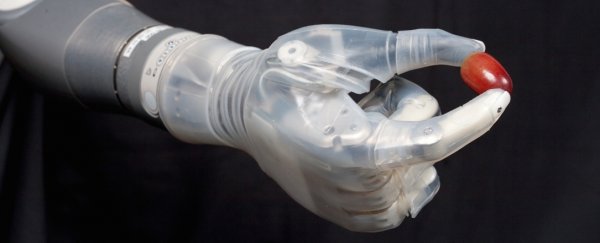
Losing a limb can be a psychologically distressing ordeal. Luckily, advances in robotic prosthetics are helping people regain mobility in ways that would have previously been unthinkable.
One innovative prosthetic device is the DEKA Arm System, developed by Dean Kamen, the serial inventor who brought us the Segway - which has, for what it's worth, revolutionised city sightseeing tours, as well as airport and mall security.
In the above video, filmed at the Walter Reed National Military Medical Centre in the US, an army veteran with an upper-arm amputation is shown using the DEKA arm to scale a vertical rock wall. Minus a couple of slips, he seems to have a pretty firm grip as he slowly moves up the wall.
The DEKA Arm System, affectionately dubbed "Luke" (as in Luke Skywalker), was funded by the Defense Advanced Research Projects Agency (DARPA) and developed by Kamen's engineering firm, DEKA Integrated Solutions, in New Hampshire, US.
In this 2007 Ted Talk, Kamen discusses how the project was born:
"A very senior person at the Department of Defense came to see me and said, '1,600 of the kids that we've sent out have come back missing at least one full arm. Whole arm. Shoulder disarticulation. And we're doing the same thing we did for - more or less - that we've done since the Civil War, a stick and a hook. And they deserve more than that.'
And literally, this guy sat in my office in New Hampshire and said, 'I want you to give me something that we can put on these kids that'll pick up a raisin or a grape off a table, they'll be able to put it in their mouth without destroying either one, and they'll be able to know the difference without looking at it.' … I said, 'Look, you're nuts. That technology's just not available right now. And it can't be done. Not in an envelope of a human arm, with 21 degrees of freedom, from your shoulder to your fingertips.'"
Fortunately, Kamen disregarded his initial assessment, and in 2006 assembled a team that began working on the device.
In May 2014, the US Food and Drug Administration (FDA) granted permission for DEKA to begin marketing its device commercially after reviewing clinical information, including a Department of Veterans Affairs study where 36 amputees provided feedback on how well the prosthetic arm worked.
According to the FDA announcement, "approximately 90 percent of study participants were able to perform activities with the DEKA Arm System that they were not able to perform with their current prosthesis, such as using keys and locks, preparing food, feeding oneself, using zippers, and brushing and combing hair." Apparently, rock-climbing should be added to this list.
The battery-powered prosthetic arm is about the same size and weight as a natural arm. It can be adapted to fit people with different types of arm amputations, and has electrodes that detect the signals caused by muscle contractions close to where the device is attached.
The electrodes then send these signals to a computer processor in the arm, which translates them to one of 10 specific movements, including six different grips.
"This innovative prosthesis provides a new option for people with certain kinds of arm amputations," said Christy Foreman, director of the Office of Device Evaluation at the FDA's Center for Devices and Radiological Health, in a statement.
"The DEKA Arm System may allow some people to perform more complex tasks than they can with current prostheses in a way that more closely resembles the natural motion of the arm."
DEKA has posted the below video of people using the system and showing off its versatility, by drinking from a water bottle - a task that is considered tricky because bottles can be slippery, their shape can deform, and they contain moving contents:

This device joins the growing list of impressive prosthetics, such as flexible, temperature-sensing skin and mind-controlled limbs. We're excited to see what's next.
Sources: Live Science, FDA
